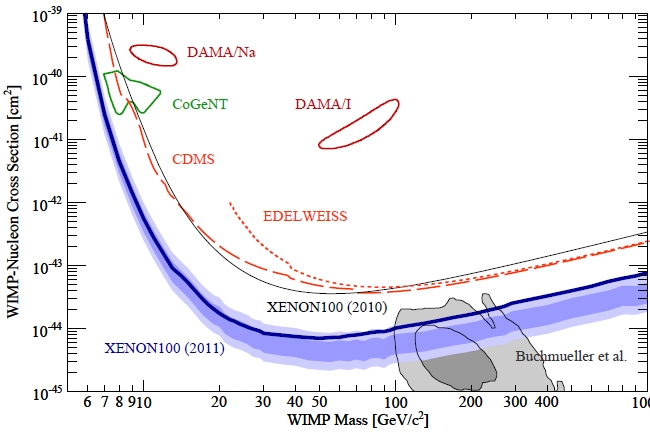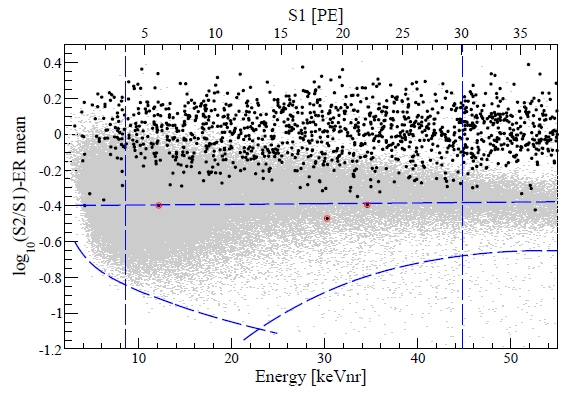Xenon 100 finds three events compatible with a dark matter signal, with a background expected from more mundane sources amounting to 1.8+-0.6 events. The limit they extract on the cross section versus mass of the hypothetical particle are shown below by a thick blue curve, which cuts into the flesh of the preferred parameter space of constrained minimal supersymmetric theories (in grey), pushing them farther away.

Ok, now the busiest of you can leave, and let's discuss some details. XENON 100 is a liquid xenon detector located in the underground laboratories of Gran Sasso, in central Italy. Thanks to the massive rock above the lab, which shields it from cosmic ray muons by a factor of a million, and thanks to the ultra-pure active material, plus the excellent position reconstruction of the charged and light signals obtained in the time projection chamber, XENON is an almost background-free probe of the faint signal that dark matter particles could deposit.
The data analyzed was recorded during the first six months of last year. The current configuration of XENON had 99 kilograms of liquid as a veto for radioactivity and cosmic rays, and 62 kilograms as active target. Photomultiplier tubes read the prompt signal of a interaction in the liquid (S1) as well as the delayed one due to ionization drift (S2), and by a combination of pattern analysis and timing information determine the 3-Dimensiona position of the primary interaction in the volume, allowing for a very good discrimination of backgrounds.
Before the analysis of real data, a pre-defined signal region had been selected in the plane constructed with the signal energy and logarithm of the ratio of delayed versus prompt signals: this discriminates well the potential dark matter signal (low S2/S1 ratio) from backgrounds due to radioactivity (gamma rays or beta rays). You can see the signal region as the one delimited by the dashed lines in the figure below. The three red points are the signal candidates.

I have to say I am not an expert of these detection techniques for dark matter signals, so my opinion on the trustworthiness of the results is not particularly useful; still, here it is. I think the analysis is quite careful, and I believe the results are correct. Further, one cannot fail to observe a posteriori that two of the three events lie very close to the boundary of the signal box....
INLINE UPDATE: After posting this article, I realized I had not provided a link to the preprint, which is here. Also, a collaborator of Xenon sent me a kind private email to point out that it does not matter for the limit where the three events lay, since they extract the limit using the probability density functions of backgrounds. That's quite okay, and I am happy to hear they took the distributions into account. However, that rings a bell.
In the limit plot above, there is a blue band which shows 1- and 2-sigma expected limits together with the actual limit observed. You should know that we live in a very uncertain time with respect to the methods experiments use to set upper limits, and even more the methods they use to compute 1- and 2-sigma bands. The matter is indeed a complicated one, and I do not want to discuss it here. However, I cannot fail to notice that the band appears to be quite narrow in the high-neutralino mass region, if compared with the fact that the observed data (3 events, two of which are close to the boundary and thus very background-like) are not very far from the 1.8+-0.6 expected from background sources (the observed limit is higher than the expectation for high masses because that's where the energetic events weigh in the most).
What I mean to say is that the observed limit lays at the upper 2-sigma boundary for masses above 100 GeV. Their paper, on the other hand, says clearly that there is a 28% Poisson probability of 1.8 events fluctuating to three or more. So the bands must have been computed without accounting for the possibility of Poisson fluctuations, by conditioning in some way. The paper is not enough detailed to figure this out, but I think the bands are deceiving.
[Further inline update: with a clearer mind this morning I am re-evaluating the band. The fact they use the energy of their candidates in the limit extraction made me have second thoughts about this. Perhaps it is a little too presumptuous (I mean, even too much for a presumptuous person like me) to imagine that we can tell by eye whether the band is correctly computed or not. My default answer to such a question has recently became "no", but that has nothing to do with Xenon100...
Elaborating this a bit: if the limit is at the 2-sigma limit at high mass, that could indeed be taken to mean that Xenon has a first faint signal of dark matter particles in their data! I have seen people getting excited for two-sigma deviations in the past, so if you are a SUSY enthusiast you might well take the stand that the result is actually encouraging, contrarily to what I conclude at the bottom of this post...]
Another concern is the fact that Xenon uses the Profile Likelihood method to set upper limits, but it is known that the limits one obtains that way are not precise in the case of small event counts. But again, these are details... In the end, whether they excluded a bit more or a bit less with their data is only important now - in a few years, these regions of the parameter space will be excluded by other searches anyway.
[End of inline update]
In any case, it is quite exciting to see supersymmetric theories being gradually pushed off the board. In the paper, the XENON collaboration does provide a comment on this:
This result excludes a large fraction of previously unexplored WIMP parameter space, and cuts into the region where supersymmetric WIMP dark matter is accessible by the LHC. Moreover, the new result challenges the interpretation of the DAMA and CoGeNT results as being due to light mass WIMPs.With the LHC experiments actively excluding large swaths of SUSY parameter space, and the coming of age of XENON, it seems we have entered a very sorrowful era for SUSY aficionados...



Comments